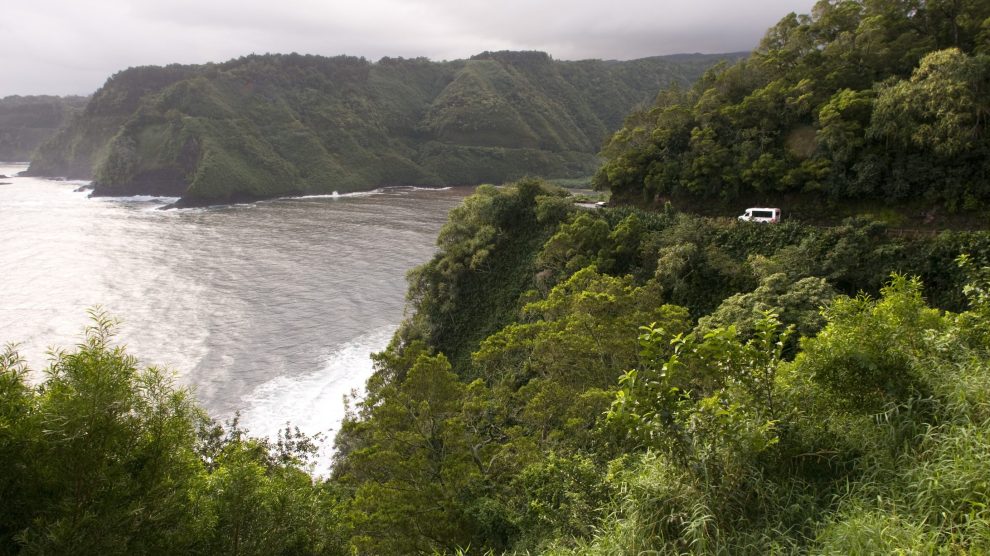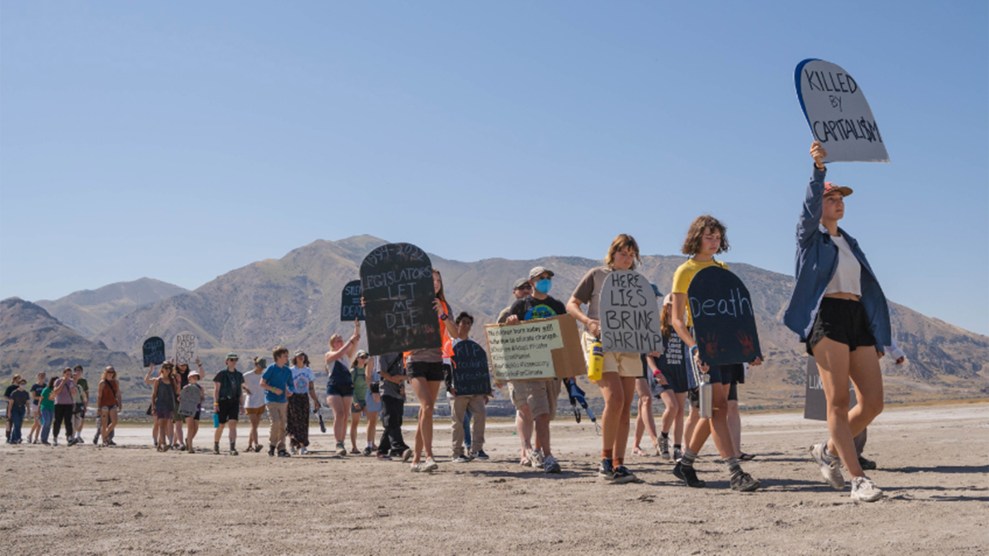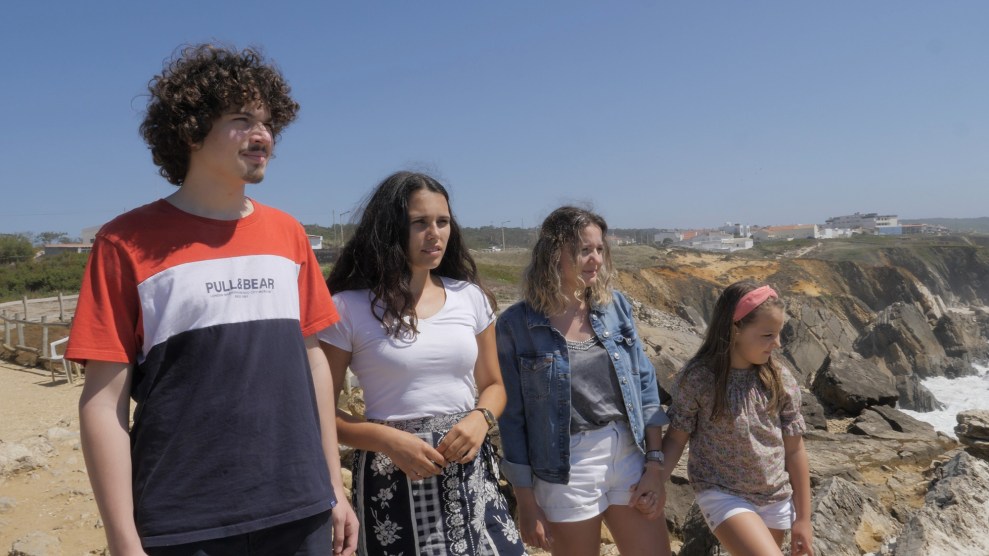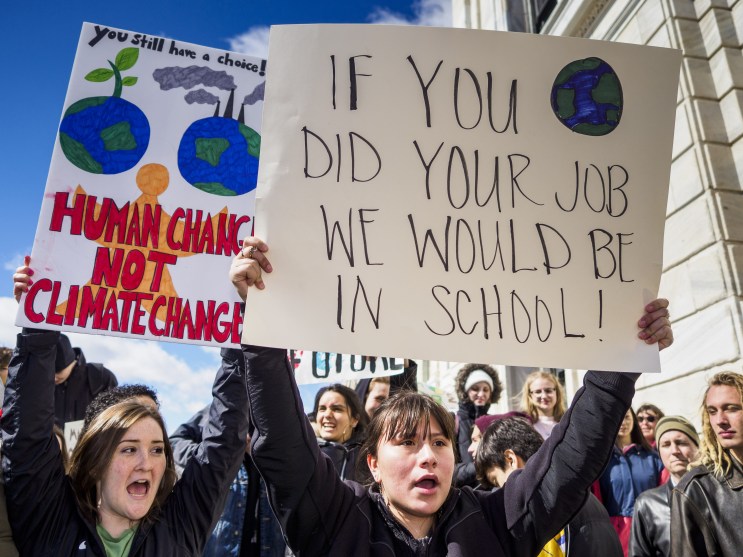
Looking down on the Pacific Ocean from the Hana highway in Maui, Hawai'i.Sergi Reboredo/ZUMA Press
This story was originally published by Hakai Magazine and is reproduced here as part of the Climate Desk collaboration.
Fifteen-year-old Brianna K. (known as Kū) loves listening to her family tell stories about the wildlife they grew up with along the shores of west Maui, Hawaiʻi. The stories describe diverse, vital ecosystems. They tell of things that have been lost.
“Older generations will talk about different seaweeds or different fishes that they used to see in places that I swim in now. And when I go out there with my dad or my parents or my cousins, you don’t see too much of it,” Kū says.
In just the past few years, Kū has watched her father’s farm produce fewer crops. Fishermen are bringing in smaller hauls, too, and her family’s household patches of kalo—a Hawaiian staple crop—are shrinking. In school, Kū says, she learned that these are the signs of climate change and how it’s affecting her community.
Now Kū, alongside 13 other young people, is suing the Hawaiian government for its failure to protect her constitutional right to a clean and healthful environment. Their lawsuit, filed in June and supported by the US nonprofits Our Children’s Trust and Earthjustice, is challenging the state’s Department of Transportation for operating a transportation system that the youth claim prioritizes fossil fuel–powered cars over mass transit and other environmentally friendly alternatives, contributing to greenhouse gas pollution. Their goal is to force the department to fully decarbonize by 2045.
Over the past two years alone, nearly 500 climate change–related lawsuits have been brought to courts around the world, according to a report by the London School of Economics’ Grantham Research Institute on Climate Change and the Environment.
But where most of these lawsuits pitch climate change as a problem that has yet to unfold—either by challenging government carbon targets and policies, or by accusing fossil fuel companies and other high-polluting industries of spreading misinformation or cutting their emissions too slowly—Kū and her co-plaintiffs’ lawsuit is just one of many recent legal challenges that is taking a new approach to try to force governments to reckon with climate change.
In addition to arguing that Hawaiʻi’s carbon emissions are affecting Kū and her co-plaintiffs’ right to future livelihoods and culture, they are suing over the harm that has already been done.
To Kim Bouwer, a legal expert focused on climate and energy at Durham University in England, the case follows in the spirit of one of the first lawsuits to explicitly link climate change to contemporary damage.
In 2008, the residents of Kivalina, an Alaska Native village on the edge of the Chukchi Sea, sued ExxonMobil and other fossil fuel companies for the damage the community had already felt from climate change–induced flooding and coastal erosion. The Kivalina residents documented very clearly the impacts the community had felt, says Bouwer. “The problem there,” she adds, “was the courts didn’t want to hear them.”
The Kivalina lawsuit was dismissed. The judge overseeing the case, US district judge Saundra Brown Armstrong, wrote in her decision that regulating greenhouse gas emissions is a political, rather than a legal, issue. As such, she wrote, it had to be resolved by the US Congress. A last-ditch attempt to take the case to the US Supreme Court also failed.
The residents of Kivalina, Alaska, sued fossil fuel companies for damages owing to the loss of sea ice and increased coastal erosion.
Over the past 14 years, however, judges, at least in some jurisdictions, seem more willing to accept that people who are suffering the worst impacts of climate change have the right to make those arguments in front of a court.
Something else important has changed since those in Kivalina filed their lawsuit in 2008; scientists have vastly improved their ability to directly link real-world events to climate change.
A report by the United Nations Intergovernmental Panel on Climate Change (IPCC), published in February, for instance, pulls no punches in its conclusion that climate change has unequivocally disrupted human and natural systems. It says anthropogenic warming has already caused substantial damage to ecosystems, water security, food production, and peoples’ health and well-being. Climate change is already disrupting cities, settlements, and infrastructure—especially in low-lying small-island developing states and atolls, which are particularly vulnerable to sea level rise.
While broad, extensive reports like the IPCC’s have helped build a scientific basis for explaining climate change’s effects, they’re not always enough to satisfy a court that a specific change in a particular place, or a specific extreme event like a storm, heatwave, or flood, was caused directly by global warming.
That’s where the fast-moving field of attribution science comes in.
Scientists, like those involved in the World Weather Attribution initiative, are now adept at cutting through the noise to show the extent to which climate change has made a particular extreme weather event more likely or more potent. Some recent examples, among many, show how climate change increased the chance of devastating bushfires in Australia in 2019 and 2020 by at least 30 percent. It exacerbated heavy rainfall in South Africa in April 2022, making the devastating flooding that killed hundreds of people and displaced tens of thousands heavier and more likely. And global warming amplified a long-running heatwave in India and Pakistan that killed dozens and ravaged crops.
“We know so much more now about the science,” says Bouwer. “It is now possible to have sufficiently persuasive scientific evidence that both links the behaviors of corporates or national governments to climate change and, to some extent, can attribute specific events or specific impacts to climate change.” When it comes to winning a lawsuit, Bouwer says, that’s what you need to succeed.
Against this backdrop, litigants like Kū are moving ahead. While the lawsuit against Hawai‘i’s Department of Transportation was filed just a few months ago, roughly 7,500 kilometers to the southwest, Torres Strait Islanders are fighting a similar fight—though theirs is much further along.
Situated between the northern tip of Queensland, Australia, and Papua New Guinea, the Torres Strait Islands are mostly populated by Torres Strait Islander peoples with their own distinct cultures, languages, and identities. The islands are extremely low-lying and are some of the most vulnerable places in the world to climate change. Data from the Torres Strait Regional Authority shows that sea level around the islands is rising by six millimeters each year—twice the global average.
For years, Torres Strait Islanders have mobilized against climate change, including a three-year effort to take Australia to the United Nations to accuse it of breaching the Torres Strait Islanders’ fundamental rights to culture and life by failing to adequately cut national carbon emissions. In September, the UN Human Rights Committee agreed with them and said they should be compensated.
Two Torres Strait Islander people are taking a different route. Much like Kū in Hawaiʻi, Guy Paul Kabai and Pabai Pabai sued the Australian government. They argue that Australia breached its legal obligations to prevent the loss of their communities to climate change. According to their lawyers, Kabai and Pabai’s case is unusual in being brought by people suffering from the impacts of climate change against their own state—a state which is one of the world’s big per capita carbon dioxide emitters.
In their filing, Kabai and Pabai outline the range of harms Torres Strait Islander peoples are already experiencing: higher average temperatures, more frequent and severe heatwaves, coastal erosion, and more potent storm surges. Even cemeteries are at risk. The documents describe how, on land, salt water has contaminated freshwater ecosystems. In the ocean, warming and acidification have led to visible coral bleaching and are disrupting the marine food web.
Kabai and Pabai do not hesitate to describe climate change as an existential threat to their communities. “Our ancestors have lived on these islands for more than 65,000 years,” says Kabai in a press release. “If you take away our homelands, we don’t know who we are. We have a cultural responsibility to make sure that doesn’t happen and to protect [our] country and our communities, culture, and spirituality from climate change.”
In yet another case, in Indonesia, four residents of Pulau Pari are hewing closer to the playbook laid out by the residents of Kivalina in 2008.
Pulau Pari, an island a few dozen kilometers northwest of Jakarta, has already seen flooding and extensive damage to houses, streets, and businesses. But rather than taking action against the Indonesian government, the residents of Pulau Pari are suing Holcim, a Swiss company that manufactures cement, concrete, and other building materials.
The islanders argue that because Holcim is one of the 50 biggest carbon dioxide emitters in the world it bears a proportionate responsibility for the resulting climate change. They want the company to slash its carbon emissions to limit future harm, and are asking for compensation and money to build new flood defenses.
Whether the courts will rule in favor of Kū and the other Hawaiian youth, Kabai and Pabai, the residents of Palau Pari, or any of the plaintiffs in other similar cases remains to be seen. But unlike the residents of Kivalina, who tried and failed to secure a judgment in 2008, many of the cases underway now are standing on a stronger legal footing.
The Hawaiian claimants, in particular, are optimistic. Leinā‘ala Ley, a senior associate attorney at Earthjustice and co-counsel in the lawsuit, says the basics of climate science are well established in Hawaiian politics and law. The state’s supreme court has already concluded that climate change “harms present and future generations” and that Hawai‘i is “vulnerable to the ecological damage caused by an unhealthy climate system.”
Ley adds that many harms are readily visible on the island, from drought conditions to roads crumbling into the sea. “We don’t have to look to the future here. We can just look unfortunately to the present to see the kind of havoc that climate change is wreaking.”
For Nikki Reisch, director of the climate and energy program at the Switzerland-based Center for International Environmental Law, the growth in lawsuits like these reflects the deep geographical and social injustices of climate change.
“It’s no surprise that many of these cases are being brought by islanders or island populations, because they’re among the most vulnerable … to the truly existential threat that climate change poses,” she says. “As the devastation caused by climate change becomes increasingly apparent, it will only become easier to connect the dots between polluting activity and the failure to reduce and regulate it—and ever harder to deny responsibility for the consequences of that action.”
And it’s only appropriate, Reisch adds, that the lawsuits are being brought against the high-emitting wealthy countries and biggest polluters “that are responsible for the lion’s share of the planet-warming emissions to date.”
Back in Maui, Kū has a keen sense of what is at stake. “It would be cool to see the same thing that my grandpa got to see when he was growing up, or be able to work in my family’s land up in the valley and be able to restore a bunch of other kalo patches up there.”
Kū is no stranger to going to court, having already testified in local lawsuits about water resources. But if the lawsuit ever gets to that stage, she is excited about the idea of making a stand on climate change. “Hopefully, it would make a huge impact on not just my island or our community, but like the whole entire state. It would be amazing.”













